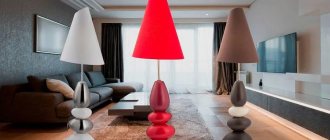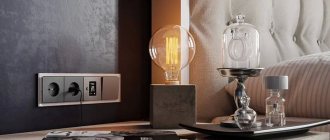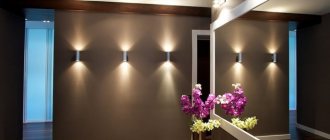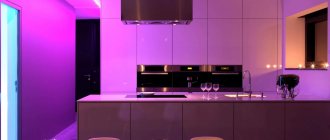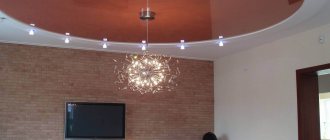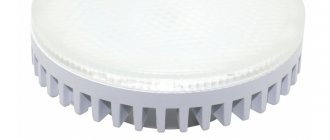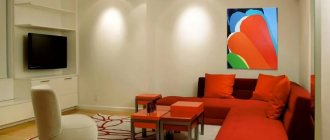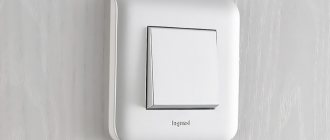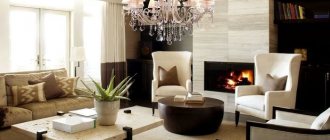What are lighting spots?
The main advantage is the ease of placement on walls and ceilings.
The lamps can be rotated, which will help illuminate the desired object and highlight important details in the room. Spots can be either a single light source or part of a lighting composition. The lamps do not put pressure on vision - they have a comfortable brightness for the eyes.
Kinds:
- Built-in – installed in a suspended ceiling.
- Overhead – attached to a special bracket that is installed on the ceiling.
- Combined - there are two or more sources in the housing that can be independently directed.
Based on the light source, there are classic and LED spots. Installing spots does not require knowledge or skills, it is only important to follow safety precautions. Spots are universal devices that are suitable for large and small apartments.
Types of lamps:
- LED;
- halogen;
- incandescent lamps.
Choose the right material. Most often, metal or thermoplastic is used to create spots. If the spot will be used as an additional lighting device, it is better to choose a material made from temperature-resistant plastics. For spots that are used as the main light source, it is advisable to install metal structures.
Types of lighting devices
The versatility of spots frees you from the need to apply classification according to the installation location: products of this type can be easily installed on both walls and ceilings. At the same time, there are exclusively ceiling models equipped with decorative pendants. The presence of PVC film material does not create obstacles to the use of lamps: the main thing is to adhere to the recommendations regarding the power of the installed lamps.
This opens up wide scope for the implementation of various design ideas that involve placing lighting fixtures next to the stretch vinyl covering. In this way, very beautiful effects are created on single-level and multi-level structures.
The classification of devices of this type is carried out according to the method of installing spots in a suspended ceiling:
- Embedded
. These models are installed directly on the base floor. For their functioning, special holes are made in the PVC film, decorated with decorative lampshades. The body itself and the movable bracket are located inside the ceiling space. - Hanging
. These designs are also called combined. The main surface of the ceiling also protrudes from where the devices are installed. Unlike recessed lamps, pendant lamps are very similar to conventional chandeliers, emitting directional light. A traditional hook is used to attach the main part of the combined spot. The lamp is brought out through a hole in the tension fabric, reinforced with a tread ring. The main part of the fastener is hidden from visual view by a decorative film. Only one or several decorative shades protrude outward. - Invoices
. These spots for stretch ceilings have impressive dimensions. In addition, the entire fastening structure in this case is visible: it is placed indoors under a tension covering. As a basis for fixing overhead devices, special wooden inserts are installed under the canvas. - Tensioners
. We are talking about a combination of a series of lighting fixtures, for the fixation of which ropes stretched across the room are used. As a rule, products of this type are most often used when decorating interiors in the “techno” style. For this reason, tension spots are not very popular among the population.
When determining which spots are best for suspended ceilings, you need to focus on the tasks that are set for lighting devices in each specific case. All of the models mentioned can be used separately, or you can create interesting combinations from them. To do this, a diagram of the placement of lamps on the ceiling covering is drawn up in advance.
What types of spots are there?
Products are classified by type of fastening. There are the following types of spots.
Ceiling spots
They become a complement to central lighting or completely replace it. The advantage of ceiling products is that it provides the ability to change the direction of the reflector. Thanks to this, you can focus on different interior details, highlight a work area or a place to relax. These lamps have small dimensions, so they are suitable for rooms with low ceilings.
The photo shows the design of a small kitchen with a ceiling equipped with black spotlights.
Wall spots
Such models can be excellent decorative lighting for hanging shelves or wall paintings. Placing the spots above a desk or computer desk will not take up much space and will completely replace a table lamp. Wall-mounted products are also sometimes used as a night light, the main thing is to choose the right power.
The photo shows wall spots located above the TV area in the living room interior.
Built-in
Built-in structures are known to many as adjustable spotlights. In this case, the direction of the light can be slightly changed. Built-in spot spots are used to illuminate small functional areas. To achieve uniform illumination, you can slightly adjust the light flow.
The dimensions of the spot devices are small, and installation requires only making a small hole in the suspended ceiling. Ceiling recessed luminaires are installed using spring clamps.
Invoices
Overhead rotary structures differ from built-in lamps only in the installation method. According to the installation method, they most closely resemble sconces. A special bracket is used to secure them. It is attached to the ceiling, and a lamp is attached to it using screws.
Their advantage is that there is no need to cut a hole in the ceiling. This will allow you to change designs to others at any time.
Complexly combined
The devices differ from spot ones only in that one housing can contain several light sources that can be directed independently. Such designs are most similar to chandeliers. Their main advantage is the ability to effectively illuminate all rooms and direct streams of light even to remote corners of the room.
In addition to the above types, spots are divided according to the shape of the base. There are spots on a bar, as well as designs on a square, round or flat base.
Spots with bracket mounting
It is a very popular type of mount, which allows for free change of light direction. Products may have one or more reflectors. The open mount has different shapes, thereby creating a complete structure that looks quite impressive.
Spots with pole mounting
This model is equipped with several lamps arranged in one straight or curved line. Certain products have a flexible rod that can take on any configuration. With the help of such fastening, the devices are used as original lighting for niches or walls. The design can also act as central lighting for a small room.
The photo shows ceiling spots on a square-shaped rod in the interior.
More about spot lighting
Depending on the design idea, lighting on the ceiling will allow you to distribute light sources throughout the room as much as possible, highlight important areas, and hide individual parts in the room
It is important to understand that using traditional light sources you will not be able to get point light. They use special lamps for the ceiling - they are low-power, otherwise they are called spots
A system based on spotlights can be installed either in suspended or suspended ceilings. This can be a structure in the form of a multi-level ceiling made of plasterboard, MDF, or aluminum panels. These lamps look great in a plastic ceiling.
Key Features
The main feature of any spotlights is the small angle of light dispersion. So, the angle is 30 degrees. Only a small part of the room is illuminated. Considering this fact, the arrangement of lamps should be very dense. Another feature is that the light flux has a conical shape.
Advantages and disadvantages
This type of lighting has both pros and cons, but first let’s highlight the main advantages:
Spot light makes it possible to only partially illuminate a particular room. Many people only need lighting for a few objects. Unnecessary areas should not be illuminated.
Lamps can be placed in any part of the room and thereby obtain the most illuminated room. Often powerful chandeliers are not the best way to illuminate remote corners and places.
Another important advantage is the complete absence of shadows. At any point in the room, flow is created directly overhead, which significantly reduces shadows
At the same time, light is also supplied from other parts of the room.
Cost-effectiveness can also be highlighted. One ceiling light uses less electricity to operate than large chandeliers that illuminate the entire room.
A spotlight scatters light streams at small angles, making it possible to illuminate objects from below. This is very beneficial in terms of design. The quality of light is much higher - it is brighter.
Compared to a traditional chandelier, the service life of spotlights is longer, which allows you to save money on their purchase.
Often, to organize such a solution, it is necessary to supply a current with a voltage of 12 V. This increases safety several times and also saves resources.
With the help of these lamps you can get a multi-colored glow - this allows you to play and try new things. This enhances the beauty of the interior.
These systems are much cheaper in terms of the cost of lighting fixtures. You can’t buy a large and powerful chandelier for this money.
Spot lighting is beautiful, safe and economical
Now about the disadvantages, of course, this is far from ideal despite all the advantages:
There are certain difficulties in the process of designing and organizing lighting. The system consists of a large number of devices, so creating a project will require larger investments than developing general lighting systems.
Some types of lighting fixtures may require a special ceiling design, such as a suspended ceiling, which is not suitable for small rooms with a low ceiling level.
If you plan to install 12 V lamps, then they will need transformers or separate power supplies.
If you have a low ceiling, then it is better to avoid this type of lighting.
Criteria for selecting lamps
Thanks to different shapes, materials of production, decor of brackets and lampshades, spots on the ceiling look completely different. Photos of the diverse design of lighting equipment will help you choose models that organically match the decoration of the room, the color of the furniture upholstery, and decorative elements.
When choosing lighting equipment, you need to focus not only on its appearance, but also consider the characteristics in detail:
- The number of cartridges determines the brightness of the light sources. Several light bulbs are placed in parallel or on opposite sides at different angles, significantly expanding the illumination area and the dynamism of the light beam. The choice depends on the functional purpose of the spots. To illuminate the fireplace area or other seating area with soft diffused light, it is enough to install a lamp with a single socket on the ceiling. Above the bar counter, dining table or countertop, where it is customary to do cooking, it is wise to hang ceiling spots with several cartridges. In bright lighting, dishes and cocktails look much more appetizing than in dim light.
The brightness of the lighting depends on the number of cartridges
- The type of fastening of built-in models does not play a special role in the design of the ceiling. Reinforcing parts and fasteners are hidden in the space between the concrete and plasterboard slabs or tension fabric. Overhead and suspended models are attached using string track cables, rails, rods, and flat bases of various shapes. Spots for suspended ceilings have a special type of fastening. Photos of the installation of bases in the form of a platform according to the marked layout of lighting equipment before installing the canvas will clearly demonstrate the ease of performing fastening work. It is worth emphasizing the optimal way to connect ceiling spots: with a parallel connection to the electrical network when the lamp burns out, the lighting system will continue to work minus one light source.
Ceiling spots are not difficult to install yourself
- The design of lamps is striking in variety. Brackets can follow the shape of a spiral, zigzag, arc, infinity sign and many other geometric shapes. Lampshades are made from thermoplastic, chrome steel, wood, glass, porcelain. Depending on the material of production, the coating of the lampshade is polished to a shine, nickel-plated, anodized, perforated, burned, tinted, glazed in order to obtain a unique design.
The design of lamps is very diverse
Spot lighting in different rooms
It is important to consider that in different rooms the approach to organizing spot lighting must be different. Further in the article we will look at the features of each room.
Photos are attached as options for the location of lamps.
Hallway
Typically, for hallways, designers recommend using the simplest possible methods for placing lighting equipment. If we talk about the features of suspended ceilings, then in this case it is necessary to use a different approach. In narrow hallways, a row of 3-5 light bulbs will be enough. For a square room, two rows of four light bulbs each are enough.
In cramped spaces, a ceiling with a glossy sheen will look good. In this case, the lamps should be located below - it is worth choosing pendant models. But modern designers advise hiding the lamps so that only the light from them is noticeable.
Kitchen
There should be a lot of light in the kitchen. During the preparation of various dishes, as well as during the process of cleaning the countertop and sink, the lighting should be bright enough. Here you won’t be able to get by with just spot light; you will need additional lamps.
It is best to make several light options - one bright, and the second soft and gentle. This will allow you to get enough light for work, as well as create a pleasant atmosphere when relaxing in the kitchen. The dining area is illuminated by low-hanging lampshades or chandeliers. Look how it looks in the photo.
Living room
Most often this is the largest room in a house or apartment. It should be as light as possible here. The ceilings are always decorated with chandeliers, and low-power light sources are located on all sides of the room. If the chandelier is turned off, the lamps will provide a soft, dim light.
The room looks good when the lighting is installed on only one side of the suspended ceilings. This way you can get both soft light and twilight. You can completely abandon the central chandelier, but you should increase the number of built-in lamps.
Bedroom
Built-in LED lights in suspended ceilings are considered common here. No chandelier needed. The lamps will give the necessary soft glow, which will be quite enough. If the room is small, then appliances covered with moldings and cornices in the ceiling will look great.
Children's
Experts recommend choosing combined lighting for a child’s room. It may be a chandelier, but not heavy or crystal. Also a good choice is spotting around the entire perimeter. It is better to choose halogen lamps - they give a bright, but not blinding light. The child’s working corner is illuminated separately.
If you want to get something special, then you can use numerous design ideas. Using a stretch ceiling, you can create a fairy-tale room for a child and organize wall lighting.
Bathroom
There is no need for a lot of bright lighting in the bathroom. Basically, up to 10 devices that give a soft glow are enough. These lamps will illuminate decorative elements, tiles, and plumbing fixtures. See the photo of the bathroom - they show what can be done from an ordinary interior with the help of light. A bathroom can be cozy, and it's not that hard to do.
How many spots are needed and how to place them
To determine the optimal number of spotlights (if you mean main lighting), there is a special formula, but the calculation can be done in a simpler way. To do this, the following calculations are carried out:
- The total number of watts per room is determined. The area of the room is multiplied by the number of Watts required by lighting standards per 1 m2. According to SNIP, the lighting level for a bedroom is 12 W/m2, for a nursery - 15 W/m2, for a living room - 20 W/m2.
- To determine the minimum number of lamps, the total number of Watts is divided by the power of the selected lamp.
- Inverse problem: to determine the power of one lamp, the total number of Watts is divided by the number of lamps.
- Spotlights are installed taking into account the following conditions:
- The distance to the wall must be at least 70 cm.
- To determine the distance between lamps, the length of the wall is divided by the number of spots.
- To determine the distance of the lamps from the wall, half the length of the wall is divided by 2.
Popular luminaire layouts
There are many options for lighting design, but it is not possible to name the most optimal location of ceiling lights. This is due to the fact that it is necessary to take into account many factors, from the area of the room to the location of the windows. You should also decide whether spotlights will be used as additional lighting (together with hanging chandeliers) or main lighting.
If possible, it is better to consult with a lighting designer about the placement of lamps. For those who decide to deal with this issue on their own, we can offer several standard options for placing ceiling lamps.
Figure 1. The most common schemes for additional lighting to the central chandelier
Such design options not only contribute to the uniform distribution of lighting over the entire area, but also, if necessary, allow for bright illumination of work areas.
Spots can also act as the main lighting fixtures; in this case, it is important to distribute them in such a way that they not only look beautiful, but also fulfill their intended purpose, fitting into the interior design.
Types of lamps for ceiling spots
Wall-ceiling spots can be equipped with various types of lighting elements. Depending on this indicator, the properties of the equipment differ.
Halogen lamps
Such lighting elements visually resemble classic incandescent lamps, but their characteristics are much better than conventional lamps. Their light is much brighter and is not inferior to the sun. In addition, their use makes it possible to highlight certain interior objects.
Halogen lamps are durable, energy efficient and have a high brightness rating. However, due to the fact that such light bulbs also heat up, it is prohibited to use them for suspended ceilings.
LEDs
LED lamp is the most modern and energy-efficient type of lighting elements. This is why ceiling LED spots are most often used. There are many options for diode spots. A single LED or many small elements can be installed.
Directional LED light is more suitable for illuminating a specific decorative item, but it is preferable to use multiple elements for general lighting of the room.
Diode spots are economical, reliable and durable. LED lighting elements do not heat up, so they can be used for suspended ceilings. You can buy lamps with white and yellow light, as well as different brightnesses. In addition, you can use a brightness adjustment system, so it is possible not only to direct the light through the use of suspended structures with LED lighting, but also to adjust its brightness.
Incandescent lamps
While classic chandeliers still use incandescent lamps, most modern lighting fixtures use energy-saving lighting elements. In addition, the use of incandescent lamps in spots is not recommended for a number of reasons:
- Spots with light bulbs require a reflector that will reflect both light and heat. In addition, hanging spots are most often made of plastic, which is damaged by constant heating. In this case, it is recommended to use glass structures, the cost of which is higher.
- Modern technologies are aimed at maximum energy efficiency, so diode spots are most often produced, which allow you to get even lighting and save energy.
- Incandescent lamps have a warm light. To create certain design options, the ability to vary shades is important, and incandescent lamps do not provide this opportunity.
- The heat generated by incandescent lamps can damage some surfaces. For example, it is prohibited to use such lamps for suspended ceilings. With prolonged contact, they can damage even plastic structures.
Halogen lamps
Halogen models appeared as a result of the modernization of incandescent lamps. They can be low voltage (12-24 V) and high voltage (220 V). In this case, heat-resistant quartz material is used to make a glass flask. To prevent evaporating particles of the tungsten helix from settling on the inner walls of the glass, iodine or bromine vapor is pumped into the flask. This ensures an increase in the service life of halogen lamps. The spiral gains the ability to produce light reminiscent of daylight.
Halogen models are economical, although they consume energy at almost the same level as incandescent lamps. Cost-effectiveness in their case is achieved by increasing the service life to 2000-4000 hours. The use of soft start allows you to increase this figure to 8000-12000 hours. Prices for halogen lamps are quite high
The products must be installed very carefully, as grease stains on the glass from bare hands will reduce the service life of the device.
Ceiling options
The placement of spotlights needs to be thought out in advance, especially if a suspended ceiling is to be installed.
The backlight can be located either symmetrically or in a chaotic manner.
Light sources built into a multi-level suspended or suspended ceiling will allow you to create a unique interior, highlight the architecture and atmosphere of the room.
The lighting will be uniform and of the highest quality if the devices are installed so that the rays of the light flux intersect above all elements in the room.
The best option is built-in spotlights along the perimeter of the ceiling plane. They can be switched on together with a central chandelier to create more intense lighting.
The parallel arrangement of lamps in several rows will help to achieve proper comfort in the room.
A cross-shaped arrangement of light sources will fit perfectly into a small room with a low ceiling. The corner space is equipped with single models, and a gimbal structure is installed in the center.
Also, for a small room, the arrangement of lamps in the form of a square is appropriate.
In order to illuminate a certain area, an arc-shaped arrangement of lighting fixtures is used. Thanks to this technique, it is possible to soften the strict interior.
Some rooms require the installation of light sources in a checkerboard pattern. For example, a similar solution is often found in the design of an island-type kitchen, where good lighting of all zones is required.
Mounting methods
- Classic mounting option. A special plate is screwed to the base of the ceiling using self-tapping screws or dowels, after which all wires and fasteners are hidden with a decorative platform. It serves only an aesthetic role.
- Built-in models. Ceiling spots of this type are installed only in special structures that have enough space between the ceiling and the base. In this method, all wiring is carried out inside the ceiling structure, and in the places where the lamps will be installed, a hole with a certain diameter is drilled. Its dimensions must fully correspond to the width of the lamp.
- Placement of spots on one rod. A fairly newfangled and original design technique that is rarely found in interiors. This solution will be the highlight of any room. To do this, attach a rod along the entire wall, and several deflectors are placed on it. It is worth noting that the length of such a device can be quite large.
- Moving spots. This is the most functional system; it allows you not only to turn the lamps in different directions, but also, if necessary, lower or raise them. The only drawback of this design is the many wires that hang in a chaotic manner.
- Tension spots. The latest development in this area. It consists of two stretched cables, and lamps are attached to them, which can be moved freely. This method is the most practical and convenient, but its cost is much higher than other models.
Ceiling spots are a universal type of lighting that will harmoniously fit into any interior of the room. They have an excellent and stylish design, compact size and quite comfortable design.
Installation of ceiling spots
Fastening technologies for different spots differ, but the general principles of installation are similar.
Installation of ceiling spots consists of several stages:
- Before installing the ceiling structure, a wire is laid from the junction box to the lighting fixture.
- The connection is made in parallel: from the connection device to the first device, and then to subsequent ones.
- When installing an electrical cable, it is worth taking its quantity with a margin of 26-35 cm. The excess wire will then be hidden under the ceiling structure.
- After the ceilings are installed, the fixtures are installed.
- Modern spots require the presence of step-down transformers that are connected to each device.
- When choosing lamps, you need to take into account the size of the product and the dimensions of the room. The choice of option is influenced by the height of the ceilings. The installation site must be freely accessible.
How to choose LED lamps
Before purchasing spotlights, you need to consider several important criteria that help you purchase quality products. They are as follows:
- Particular attention must be paid to the matrix. It should operate from an electrical voltage of 220 W. 12 volt models require additional installation of special power supplies. They help distribute the electrical flow evenly to all light points;
- When purchasing, it is recommended to take into account the strength of the luminous flux. Models with a cool spectrum shine much brighter, but produce light with a blue-green tint. Professional designers recommend choosing spotlights with warm light that study yellow-red rays;
- Consider the warranty period. On average, one spotlight can last from 1 to 6 years. Performance qualities directly depend on power fluctuations and proper installation of spots.
Advantages and disadvantages
Positive and negative qualities of products that will help you understand whether this lighting method is beneficial.
Advantages
- Due to their compactness, they fit perfectly into the design of any room in an apartment or house.
- Can be used both as main and additional lighting.
- They allow you to achieve zoning of space and provide light to individual areas.
- By using spotlights with LEDs or halogen bulbs, energy costs are reduced.
- This type of lighting is characterized by an unlimited choice of installation locations. The products can decorate any area, niche, arch, etc.
- Due to models with spectacular decor, it is possible to advantageously emphasize the style of the interior.
- Lamps with warm or cool shades can create a comfortable atmosphere in the room and give the design a certain mood, depending on individual preferences.
Flaws
- Surface-mounted and recessed lighting fixtures have some installation difficulties and require a professionally designed installation diagram.
- For products with 12 Volt light bulbs, the purchase of a special step-down transformer is required.
- Some types of light sources require a ceiling with a special design.
Installation Tips
Although recessed lighting fixtures are easy to install, you still need to follow some recommendations when installing them:
- In one room it is necessary to use the same type of ceiling spots, and even better if they are manufactured at the same factory. Even at the stage of purchasing such devices, it is imperative to check the completeness of their configuration, or rather the presence of cooling and reflective elements.
- If the room has suspended ceilings, then the power of the LED lamps used should not exceed 40 W. And if you need to install devices with a power of 12 W, then you will have to purchase a step-down transformer in the kit.
- With a ceiling height of 2.5 m, recessed lamps are installed at least 60 cm from the wall or partition, and the gap between the devices themselves should not be less than one meter.
- The type of electrical cable is selected depending on the number and total power of the spots, the length of the wiring, as well as the material from which the ceiling is made. For example, a simple wire is suitable for drywall, and only fireproof wire for a base made of plastic or MDF panels.
With proper installation, a recessed LED lamp can last over ten years.
Ceiling lighting fixtures have become popular not only due to their efficiency, because LEDs consume much less electricity than incandescent lamps, but also due to their design and the ability to create a unique lighting effect in the room. Also, built-in spots are ideal for installation in suspended or suspended ceilings, which are now installed in almost every home.
https://opotolkax.com/wp-content/uploads/2016/06/Potolochnye-svetilniki-i-spoty-raznovidnosti-i-tehnologija-ustanovki-min.jpg 480 640
admin
https://opotolkax.com/wp-content/uploads/2016/04/image-min.png
2016-06-11 15:46:112019-03-06 19:06:51Recessed ceiling LED spots
How to connect an LED strip to a 220 Repair of a chandelier with a remote control for your…
How to choose spots for the interior of the room
Thanks to the wide variety of ceiling spotlights and their versatility, they can decorate absolutely any interior. The style of the room and its color design are two criteria that you should focus on when selecting spots for the interior.
- If you need to organize spot lighting in a room designed in a classic style, choose rounded lines and imitation of precious metals.
- In interiors made in modern styles, such as modern, high-tech, loft and others, square and rectangular spots with glass and metal elements are appropriate.
- For suspended and suspended white ceilings in rooms of any style, spots of the same color would be a universal option.
Ceiling spots have become a part of our lives. And if once upon a time their appearance in an apartment was rather a fashionable trend, today spots solve many problems. They act both as additional light sources and are used instead of classic chandeliers, play a decorative role in the room, placing accents and highlighting a certain area, and are able to visually adjust the dimensions of the space. In addition, spots are economical, convenient, durable and easy to install. A competent choice of spots will make your home not only stylish and modern, but will also eliminate the need to replace light sources for a long time.
Lighting for decorating a stretch ceiling
Today's market offers a wide range of suspended ceilings. To choose the right lighting device, you need to understand the intricacies of this issue.
Stylistic design
To choose an original model of a lamp, luminaire, or LED strip, let’s take a look at the style options available on the market.
Types of lamps:
- classic. This type of lamps captivates with its elegance; its parts are arranged symmetrically. Ideally, when decorating a room in the classicist style, the suspended ceiling covering is made of wood, but with a suspended ceiling, it is better to opt for a hanging crystal chandelier or one that resembles a plate. The interior design can be done in Provence or Empire styles;
- country. In this situation, comfort is created with the help of wooden or carved lamps designed for suspended ceilings. In this style, lamps are used exclusively from natural materials;
- High-tech is a modern style in which materials are combined in order to recreate an extravagant design solution with the original shape of spotlights and other devices, which adds originality to the interior. The style called hi-tech is characterized by a lot of light, so it combines lamps, LED lighting and spotlights.
Distinctive features of lighting elements with rotating functions
Rotating lamps - simplicity and functionality
Lighting devices are divided depending on the presence of rotary functions. They are of the following types:
- rotary. They are equipped with rotating hinges, and the entire flow of light is directed in the desired direction, as the lamps rotate;
- fixed. A lighting device of this type directs the flow of light into the lower zone strictly perpendicular to the floor.
The photo will help you understand what characterizes each type of lamps and chandeliers intended for decorating a stretch ceiling. Also, during installation, you need to figure out how to direct the flow of light for proper distribution of lighting and even zoning of the room. The room should be comfortable, and what devices should be chosen depends on the design idea. These can be lamps, spotlights, LED strips or other lamps.
This type of lighting is economical and attractive
Differences in dimensional parameters and modifications of lamps
Devices for installing lighting for a room or other premises, according to dimensional parameters and modifications, can be:
- standard type. This option is the simplest. These are small models that do not protrude beyond the edge of the main canvas. This type of lamps is made in the form of an oval, circle, square, rectangle and triangle. In some situations, standard type chandeliers can be created in the shape of a heart or a star;
- elongated. Such chandeliers are made in the shape of a glass or candle. They usually have a rotating mechanism, which makes it possible to install the lamp in a variety of positions. For example, parallel to the ceiling, straight down or diagonally to the floor;
- volumetric. This type of chandelier is designed to decorate a small ceiling, and volume is added using various decorative elements, chains, and curls;
- spherical. These are lamps that have the shape of a hemisphere. Transparent or frosted glass is used for their manufacture. In most cases, specialized spraying of exclusive beads or sparkles with crumbs is done in order to make it more decorative. These lamps are shown in the photo;
- non-standard. These chandeliers and lamps are distinguished by their asymmetrical shape, different textures and original color designs.
What type of device is best to choose is up to the owner of the room, as it depends on the interior design of the room.
Color palette when decorating a room
Blue backlight is a good night light option
There is no doubt that every person in his home wants to focus on a beautiful ceiling. To do this, you can choose a chandelier or spotlight that will create the ideal light flux
Tips for choosing the color of lamps and chandeliers for a room:
- Eye fatigue occurs to a lesser extent in yellow light;
- to improve performance, it is better to opt for white lamps or chandeliers;
- red light may increase blood pressure;
- orange light speeds up the heart rate;
- green and blue soothe and reduce blood pressure;
- blue – depressing;
- The purple lighting device looks extraordinary, but later the person experiences irritability in such lighting.
The original model is attractive and graceful
Interior use
Depending on the purpose, you can purchase street spots and structures for decorating residential and office premises. The ability to direct lighting allows the use of lower power lamps. In this case, you can focus the light on certain interior details or diffuse it throughout the room.
Modern spotlights easily replace classic chandeliers and can be used indoors or outdoors. They are used to decorate various rooms.
Cabinet
Spots can be used to beautifully illuminate bookshelves or a desk. Unlike the classic type of lighting, spots make it possible to direct the light. Can be used in combination with floor lamps or table lamps. The office can use white or black design options, square or round designs, as well as ceiling wooden spots or crystal lighting fixtures.
Bedroom
Perimeter lighting will look great here. A good solution is to install a multi-level stretch ceiling, decorated with dim lighting.
LED strip mounted on the sides of the ceiling plane will complement spotlights advantageously.
Thanks to light sources, the bedroom can additionally be divided into an area with a bed, dressing table or wardrobe.
Living room
In the interior of a living room with a ceiling chandelier, it is better to install light sources with low power. Thus, when the chandelier is turned off, a pleasant, soft and muted glow will emanate from the lamps
In this case, point devices can be placed only on one side of the ceiling.
For a hall without a central chandelier, almost any arrangement of light sources is suitable, for example, in the form of a circle, square, oval or even a diamond.
Children's
A children's room is a rather difficult room to decorate, since it will require even more diverse lighting. The child will need to study and bright light is required in this area. There is also a play area, where the lighting should also be sufficient, but a lot of light is not always needed. And the third degree of illumination is when the child is getting ready for bed. At this time, dim soft light is required. This is a difficult task that you will have to solve when choosing the location of lamps on the ceiling for a children's room.
Ceiling lamps in the nursery should provide enough light
Most often, if the ceiling has two tiers or more, recessed lamps are placed along the edge of the “second tier”, and a chandelier is installed in the center of the first
An interesting option with spots around the perimeter of the ceiling
Multi-zone lighting, and even using lamps of different sizes and wattages
With this arrangement of lamps on the ceiling, there are at least three options for the degree of illumination
If you plan to have a ceiling of two or more tiers, it is logical to place spotlights along the border of the two tiers. It looks quite organic. If the ceiling is flat, you will have to choose from existing schemes or come up with your own.
Kitchen
Ideally, the more light in the kitchen, the better. Therefore, we do not hesitate to simply “fill” the kitchen space with light. The use of spots is possible in two options:
- as main lighting;
- combined with a central chandelier.
In the first case, experts advise placing lamps at a distance of at least 30 cm from each other. For every square meter of ceiling there must be at least one lamp with a power of 20 W. In the second case, there may be fewer spots and they are not located over the entire surface of the ceiling.
As additional lighting, place spots so as to fully illuminate the desired functional areas. It is possible to install lighting fixtures around the perimeter of the kitchen, and a chandelier in the center. Another solution would be to place it along one wall, where the work surface is.
The correct location will allow:
- visually enlarge the kitchen space;
- highlight the most advantageous architectural details;
- create light without shadows, because they sometimes simply interfere with the cooking process;
- increase the height of the ceilings if you direct the rotating spots up towards the ceiling;
- appliances built into the facades of kitchen cabinets will highlight the beauty of your unusual apron and will illuminate the work surface as much as possible;
- A two-level arrangement of spotlights is allowed simultaneously: on the ceiling in the form of rotating spots and on cabinets in the form of built-in spotlights.
A few more tips on the temperature of the light flux itself. There are several characteristics: warm, neutral, cold.
I want the kitchen to have a warm and cozy atmosphere. In the cooking area we choose daylight, i.e. neutral. It will not distort the color, it will not tire your eyes, but at the same time the lighting intensity is more than sufficient. Neutral shades include lamps with a temperature range from 3500 to 5300 K.
If you are the happy owner of a large kitchen, then there is a separate dining area. This is where warm light, white or yellowish, is quite suitable. There is no need to cook here, but a relaxing atmosphere that promotes a good appetite will not hurt. The dining area is illuminated with lamps up to 3500 K.
Lighting for cabinets and other storage areas will withstand a cool tone. Here you need lamps over 5300 K. Are you a renowned pastry chef and make cakes and other “delicacies” to order? Then cold light is what you need, because it is much brighter and helps not to leave even the smallest details unattended.
Corridor
Typically, the design of a hallway assumes the most simple arrangement of lighting fixtures. For a narrow corridor, one row of 3 or 5 point lamps is suitable. In a square room, it is appropriate to install two rows consisting of 3 or 4 light bulbs.
No. 7. Ceiling lamp and room type
We do not have the right to dictate terms to you and impose our opinion on the lighting of different rooms, but some rules should still be followed:
- in the living room it is better to create multi-level lighting so that in a matter of seconds you can adapt the room to perform a particular function; the presence of dimmable lamps is welcome. You can provide a central pendant or overhead chandelier, it all depends on the height of the room and the chosen style. It can be supplemented with spot lighting along the contour of the room and in individual zones. If you can’t install lamps, spotlights will do. Don’t forget about LED strips, floor lamps and sconces that will make the relaxation area more comfortable;
- The kitchen is equipped with a general diffused light lamp; the work area is separately illuminated using bright directional light. Several pendant lamps can be placed above the dining table, the distance from them to the surface of the table top is at least 60 cm. Preference is given to moisture-resistant and easy-to-care materials. For small kitchens, a good solution would be spots, the light from which can be directed in different directions;
- The hallway is often a compact room, but the light here needs to be bright enough, because the sun's rays do not penetrate here, and you somehow need to see yourself in the mirror before leaving. You can use a ceiling overhead lamp, spotlight or spot;
- in the bedroom, the central lamp should provide dim, soft light. If the room has a wardrobe, then the area around it needs to be additionally illuminated. It is imperative to provide lamps in the bedside area;
- For the bathroom, compact, moisture-resistant lamps with high radiation intensity are selected;
- It is better to equip the office with a common ceiling lamp, which gives a minimum of shadows, and a table lamp. Leave all original lighting design ideas for other rooms - in the office the lighting should be calm, monotonous and tuned to the work process.
Finally, we note that it is better to draw up a lighting diagram at the repair stage in order to install the wiring or create the necessary holes in advance. Proper planning will save you from a lot of problems and troubles.
Using outdoor spots
Street spots are used to illuminate the area near the house. They have great power and range of luminescence, and will also help in creating decorative effects when lighting a certain area of the yard. Street lamps are made of glass and metal in white, black, gray and other colors.
They allow you to adjust the direction of light and also have protection from the negative effects of precipitation, so street spots are the best option for lighting your personal plot.
Adjustment type
All of the above types of spotlights can also differ in the type of adjustment. Depending on this, spotlights are:
- non-rotating – illuminate part of the room, but the direction of the light flow cannot be adjusted;
- rotating - allow you to adjust the angle of incidence of light and its direction;
- rotating and retractable spotlights are used to change lighting zones.
In terms of functional features, spotlights can also vary significantly.
Modern models are equipped with remote control, have a wider angle of light incidence, protection against dust and moisture, and other functions.
Smart lighting system
The smart lighting system allows you to turn off and turn on ceiling spots in response to the presence of a person in the room.
The lighting works depending on whether there is a person in the room or not. A motion sensor is mounted at the entrance, which ensures that the lamps turn on. There are other sensors located inside the room that confirm the presence of a person. They don't let the lights go off.
Such designs are complemented by devices for manual control.
Types of spotlights
If we talk about appearance, then, in addition to round ones, there are models of square, oval and non-standard shapes. It is convenient to classify spotlights according to the place of attachment:
- Built-in. Such lighting fixtures decorate suspended and suspended ceilings, walls and stairs. They require lamps with a minimum heating level so as not to damage the base.
- Invoices (external). There are wall and ceiling; the structure is fixed with screws, the light flow is distributed by the diffuser of the outer housing.
- Furniture. Mortise and overlay spot models help illuminate furniture fronts, work surfaces, as well as the interior space of shelves and drawers.
- Hanging. Such spotlights take up more space in the interior, since installation is carried out on special mounts, and the device remains visible. Many hanging models are equipped with a rotating mechanism.
Built-in ceiling models, in turn, differ in the type of installation:
- Models for installation in rigid suspended structures (plasterboard, plastic panels, slatted ceilings); equipped with two fastening clips.
- Models for suspended ceilings. In this case, installation is carried out using special brackets before the canvas is tensioned.
Is it possible to repair spots?
You can change the lamps yourself, observing safety precautions. Ceiling spots are convenient, easy to install, multifunctional and modern lighting devices with the ability to rotate. They come in different sizes, shapes, styles, and ways to use them in the interior. Properly designed lighting will allow spots to become the main source of light in the room or highlight important areas. Will highlight her uniqueness and individuality.
Hanging
Pendant lamps are devices that are suspended from electrical ropes or cables or mounted to a perforated tray in the ceiling area. Pendant lamps are used in large rooms (halls, living rooms) or in various institutions and offices.
In modern design, hanging models are often used. This is due to the high level of functionality of the devices. They are also quite easy to install.
Pendant lights for large rooms
Lighting devices can be adjusted in height and direct the flow of light in the desired direction. This is their main difference from standard chandeliers for the home.
Scope of application and choice of location
Ceiling lamps in the interior have a wide range of design possibilities, including the following methods of use:
- Arrangement of light accents. The spots beautifully illuminate the multi-level ceiling, furniture, paintings, steps of the stairs, and the pool.
- Zoning of space. It is convenient to highlight, for example, the dining area in the living room with light. The device can be installed above a sofa or armchair.
- Imitation of the starry sky.
- Possibility of dimming (smooth brightness adjustment). Creates an atmospheric (solemn or intimate) atmosphere depending on the time of day or mood.
In different rooms, spotlights are used in different ways:
- Living room. Spots are used functionally: as local lighting or instead of a chandelier. In the first case, they are placed around the perimeter of the room, in the second, they are distributed evenly along the ceiling, in rows or in a circle.
- Bedroom. In a room intended for relaxation, bright, flooding light is useless. Therefore, white spots with frosted glass are installed here.
- Kitchen. You can’t do without high-quality lighting here. In addition to stationary ones, it is a good idea to install lamps with a rotating mechanism in the kitchen, perhaps a pair model.
- Entrance hall (corridor). In a modest-sized room, spotlights do an excellent job as the main light source. They are mounted in one or two rows along the ceiling.
- Bathroom. For wet rooms, choose waterproof models that are safe to use.
How does a spot differ from a sconce?
Many people confuse wall spots and sconces. Some models are really visually similar. And they are most often placed in the same place - near the bed or sofa.
However, the products have a significant difference - the method of inclusion. The sconces are equipped with their own switches in the form of a cord or a button on the body. Spots do not have this option. The devices are activated using a general switch or control panel if the house has a “smart light” system.
And one more difference. It is advisable to use spots for organizing general lighting, sconces - not. Devices from the second category are usually used to highlight a small area in a room with light.
Unusual ideas for placing lamps
Quite unconventional methods of installing and placing lamps in rooms are often used. In addition to the general light, they create a starry sky effect - it looks amazing.
There are a lot of different ideas, but you need to choose them wisely. The golden rule is that these ideas must be combined with the interior.
You can illuminate the picture, place lamps in a plasterboard structure at the head of the bed. Sometimes they make multi-level light. All this looks very impressive.
